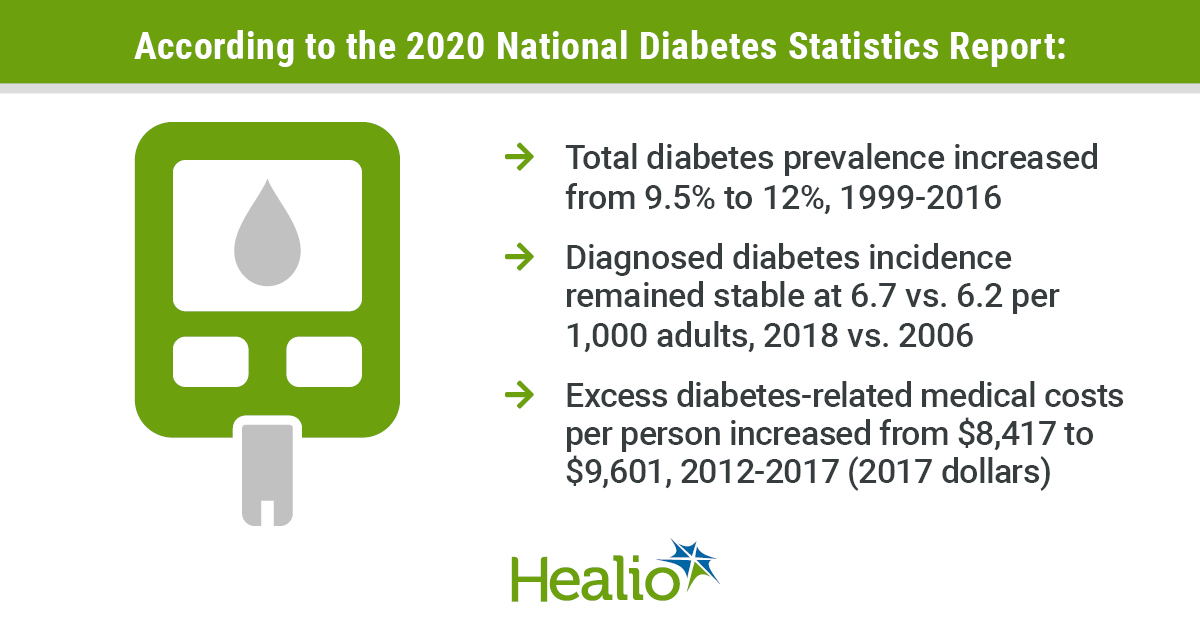CDC: 13% of US adults have diabetes, with fewer new cases
Approximately 34.1 million U.S. adults — more than 1 in 10 —have type 1 or type 2 diabetes, and 7.3 million of those adults who met laboratory criteria were unaware or did not report having the disease, according to data from the CDC’s 2020 National Diabetes Statistics Report.
The report, released Tuesday by the CDC’s Division of Diabetes Translation, also revealed that age-adjusted prevalence of total diabetes increased among adults between 1999 and 2016, rising from 9.5% in 1999-2002 to 12% in 2013-2016. However, new diabetes cases decreased during the past decade except among children and adolescents. The 2020 report marks the first time trends in prevalence and incidence estimates over time are included, according to the report.
“Data from this report can help focus critical type 2 diabetes prevention and diabetes management efforts across the nation,” the CDC states on its website.
Age-adjusted data for 2017-2018 indicated that the prevalence of diagnosed diabetes was highest among Native Americans and Alaskan Natives (14.7%), Hispanic adults (12.5%) and black adults (11.7%).
“Among adults, prevalence varied significantly by education level, which is an indicator of socioeconomic status,” the report states. “Specifically, 13.3% of adults with less than a high school education had diagnosed diabetes vs. 9.7% of those with a high school education and 7.5% of those with more than a high school education.”
During 2018, there were 1.5 million new cases of diagnosed diabetes, or 6.9 per 1,000 persons, according to crude estimates. Compared with adults aged 18 to 44 years, incidence rates of diagnosed diabetes were higher among adults aged 45 to 65 years and those aged at least 65 years.

The age-adjusted incidence of diagnosed diabetes held steady in 2018 at 6.7 per 1,000 adults when compared with data from 2000 of 6.2 per 1,000 adults.
“A significant decreasing trend in incidence was detected from 2008 (8.4 per 1,000 adults) through 2018,” the report states.
Among children and adolescents, overall incidence of type 1 diabetes increased between 2002 and 2015, with the largest increase observed among Hispanic children.
Between 2002 and 2015, overall incidence of type 2 diabetes among children and adolescents also increased, with changes consistent across racial groups.
Assessing risk factors for diabetes-related complications, estimates showed that 21.6% of adults with diagnosed diabetes were tobacco users, 15% reported current cigarette smoking and 36.4% had quit smoking. Additionally, 89% of those with diagnosed diabetes had overweight or obesity, and 38% were physically inactive. An estimated 88 million adults had prediabetes in 2018, based on fasting glucose or HbA1c level.
The total direct and indirect costs of diagnosed diabetes in the U.S. was estimated at $327 billion for 2017. Between 2012 and 2017, excess medical costs per person associated with diabetes increased from $8,417 to $9,601 (2017 dollars).
Estimated percentages and total number of people with diabetes and prediabetes were derived from the National Health and Nutrition Examination Survey, the National Health Interview Survey, the Indian Health Service (IHS) National Data Warehouse, the Behavioral Risk Factor Surveillance System, the U.S. Diabetes Surveillance System and U.S. resident population estimates.
Diagnosed diabetes status was determined from self-reported information. Undiagnosed diabetes was determined by measured fasting plasma glucose or HbA1c levels. – by Regina Schaffer
Reference:
CDC. National Diabetes Statistics Report. Available at: https://www.cdc.gov/diabetes/pdfs/data/statistics/national-diabetes-statistics-report.pdf. Accessed Feb. 25, 2020.
Disclosures: The authors report no relevant financial disclosures.
